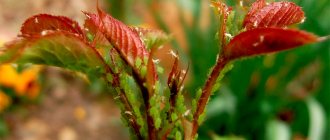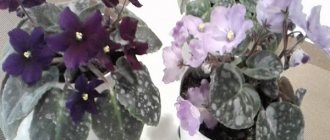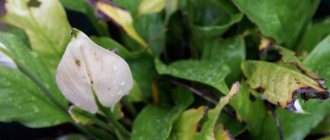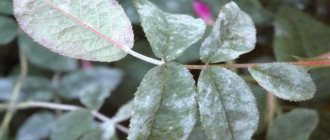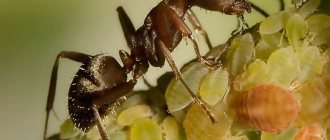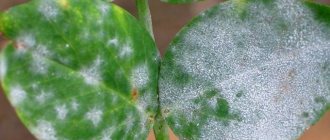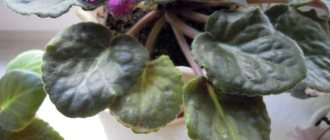Indoor plants bring undoubted benefits to humans; they create a pleasant environment and climate in the house. Today it is possible to go to the store and buy almost any indoor plant for little money. That’s why there are so many people who are interested in home gardening; sometimes this is the only way to make their apartment or office more comfortable. But indoor plants, despite their safe location, are often susceptible to various diseases, especially those that were brought from another climate zone or bred experimentally. Rust often appears on indoor flowers, but not every gardener understands what to do about it.
Basic description of the disease
Rust is a disease in which living plant tissues, mainly leaves, are affected by fungi of the Heterobasidiomycetes subclass. Rustworms do not feed on dead organic matter, so after sucking the juices from one plant, they move on to the next. Often, rust is first detected on the leaves of crops; if appropriate measures are not taken in time, this disease can destroy the entire plant.
Some species of rust go through their entire life cycle on one plant. They are usually called single-owner. Others parasitize two plants at the same time, which is why they are called multihosts. The latter pose the greatest danger.
This fungus is so tenacious that it does not die when carried by air or insects over long distances.
The number of spores ripening at the same time reaches several tens of billions. For these reasons, the area covered by rust fungi is expanding at an incredible rate, and outbreaks of the disease are breaking out in the most unexpected places.
Appearance of the affected plant
A wide variety of plants can be affected by rust, from wild plants to agricultural crops, for example:
- cereals,
- industrial crops,
- ornamental plants,
- forest tree and shrub species,
- meadow and field grasses.
A characteristic sign of the disease is clusters of orange or brown spores on the underside of the leaf and yellow oval or round spots on the top. Soon the spots turn into stripes, the leaves turn yellow, then brown or black, dry out and fall off. This happens due to metabolic and water balance disorders, and a decrease in the energy of photosynthetic processes.
If you find various orange-yellow pustules on the leaves, know that after a while they will crack and spores will spill out of them, which are popularly called rusty powder.
So, in advanced cases, the leaves and other parts of the plant (shoots, buds and flowers) infected with rust die. Accordingly, winter hardiness and yield, the quality of fruits, berries or vegetables are significantly reduced. All grain crops affected by rust lose the baking properties of the grain.
Reasons for appearance
Rust disease is dangerous because it can spread through water, wind, and seeds. Having landed on a plant, the fungus destroys it from the inside. Taking away nutrients, it literally makes breathing of stems and leaves impossible.
Flowers at increased risk of rust infection include peonies and lupins, roses and phlox, irises and lilies of the valley, chrysanthemums and other flowers and plants.
The development of the disease is facilitated by the following factors:
- prolonged cool weather accompanied by rain or abundant watering;
- thickened plantings (this interferes with the timely drying and ventilation of plants);
- application of excess amounts of nitrogen-containing fertilizers.
Types of disease
Let's look at the manifestation of rust disease using the example of some garden flowers.
- Irises. Their leaves are severely affected by rust, caused by Puccinia iridis. A huge number of brown bubbles cover the surface. The leaves quickly turn yellow and dry out. By autumn, black stripes form on the dead parts, indicating that the fungus has gone into hibernation and not disappeared.
- Clove plants. At the beginning of summer, leaves and stems infected with the pathogen Uromyces caryophyllus become covered with brown pustules. After they have matured and burst, the plant is depressed and the leaves dry out. In autumn, the bubbles take on a dark brown tint - this is a sign that the mushroom has fallen asleep.
- Bulbous plants. Leaves infected with the rust pathogen Uromyces scillarum initially show small, colorless areas that turn yellow over time. Then brownish spores appear on the leaves and even on the scales. The fate of the leaves is the same as that of irises. However, the plant itself slows down in growth and stops blooming luxuriantly.
- Compositae. The spores of this fungus, Coleosporium solidaginis, are located on the lower surface of the leaves. The affected parts soon die. In autumn, the harmful fungus overwinters in flat orange pustules.
- Lilies of the valley. Yellow round or oblong spots appear on the leaves of this flower infected with the Puccinia fungus. On the reverse side, under these spots, whitish pustules of a cylindrical shape and with inwardly curved edges develop over time.
- Cruciferous. All above-ground parts of plants of this family are damaged by white rust, its causative agent is the fungus Albugo candidae. A large number of white spores swell and bend the pads, causing the leaves to curl and die.
Bush rust
Raspberry rust
The causative agent of rust on raspberries is the fungus Phragmidium rubi-idaei, which is most harmful during periods of high humidity. When infected, small, round, slightly convex pads of a reddish color form on the upper side of the leaf blade, on the central veins and petioles. On annual raspberry shoots, gray sores with a reddish rim appear, which over time enlarge and merge, forming longitudinal cracks. Under favorable weather conditions for the fungus, several generations of spores can form over the summer. Precipitation and high air humidity contribute to the development of the disease. Severely affected leaves dry out, and the shrub's winter hardiness decreases.
In the photo: Rust disease on a rose stem
To protect raspberries from rust after harvesting, you need to remove all fallen leaves from under the bushes, cut out and burn shoots and branches affected by rust, and loosen the soil between the bushes. In the spring, the soil in the raspberry field is mulched with manure, which destroys rust spores, and the bushes are treated with three percent Bordeaux mixture before the sap begins to flow. Before flowering, the raspberries are sprayed with one percent Bordeaux mixture or another fungicide.
Currant and gooseberry rust
Two types of rust can develop on currants and gooseberries: goblet rust, caused by the fungus Puccinia ribesicaricis, and columnar rust, caused by the fungus Cronartium ribicola. As a rule, the source of goblet rust is sedge leaves, and the spreader of the columnar variety of the disease is Weymouth pine, cedar or cedar pine. The symptoms of these two types of disease are similar, but columnar rust develops more often on currants than on gooseberries.
Affected leaves, buds, flowers and shoots should be immediately removed, and the bushes should be treated with a copper-containing preparation prepared in accordance with the instructions. Repeated treatment is carried out 7-14 days after the first spraying. Preventive treatments of shrubs - in early spring, after flowering and after harvest - reduce the risk of rust infection.
Fighting methods
Rust on the leaves of garden flowers (roses, hollyhocks, hydrangeas, lilies, lilies of the valley, irises, hyacinths, tulips, carnations, asters, chrysanthemums, gillyflower, gladioli, peonies) is a contagious disease that can and should be combated. There are many folk and chemical ways to destroy rust fungus.
It will be useful to read:
Black spot on garden plants Basic description of the disease Black spot is caused by the fungus Marssonina rosae, which, when it gets on plants…
Folk remedies
- 1 tablespoon of soda, 1 teaspoon of liquid dishwashing detergent, 1 tablespoon of vegetable oil, 1 aspirin tablet, 4.5 liters of water. Mix all components and spray the plants once every 10 days.
Soda
Liquid dish soap
Vegetable oil
Aspirin
- Pour fresh manure (1/3 of a bucket) with water and leave for three days, stirring it from time to time. Filter using a strong cloth, then dilute with water in a ratio of 1:10. Spray plants only in the evening to prevent sunburn on the leaves. For a new treatment, it is necessary to prepare a fresh infusion.
Chemicals (fungicides)
In the fight against rust, 1- and 2% solutions of multifunctional contact and contact-local sulfur- and copper-containing preparations are most successfully used, including:
- Flint Star;
- "Colloidal sulfur" (cumulus);
- "Bordeaux mixture";
- "Oxychom";
- "Falcon";
- "Coronet";
- "Copper oxychloride."
In rainy weather, during treatment with chemicals, you need to add so-called green soap or adhesive to the prepared solution. Its function is to fix the fungicide on the surface of the leaves.
It will be useful to read:
Powdery mildew on roses and other plants The fight against powdery mildew (ashtray), a widespread and dangerous disease for many plants, must...
Anti-rust preparations (fungicides)
We offer you a description of the most effective fungicidal preparations in the fight against rust:
- Abiga-Pik is a copper-containing broad-spectrum fungicide used to combat a complex of bacterial and fungal diseases;
- Azophos is a new generation fungicide for the destruction of fungal microorganisms. Environmentally friendly product;
- Baktofit is a biological fungicide and bactericide intended to combat fungal and bacterial plant diseases;
- Bordeaux mixture is a copper-containing broad-spectrum fungicide to protect vegetable, fruit, berry, citrus, melon, ornamental and flower crops from a range of diseases;
- Vectra is a contact-systemic, therapeutic and protective fungicide that destroys spores of phytopathogenic fungi;
- Cumulus is an inorganic contact preparation for combating fungal infections on plants;
- Kuproxat is a contact fungicide with preventive and eradicating action, designed to combat a complex of fungal diseases;
- Medex is an effective fungicidal preparation based on copper sulfate and used to combat fungal diseases of plants;
- Pencozeb is a protective contact fungicide used for preventive treatment of plants against fungal infections;
- Polyram is a highly effective protective drug used for preventive purposes;
- Skor is a systemic fungicide with a prolonged preventive and pronounced therapeutic effect, used to combat fungal diseases;
- Strobi is a highly effective broad-spectrum fungicide for the control of fruit, ornamental and vegetable plants;
- Topaz is a systemic fungicide used primarily for the prevention of fungal infections at the beginning of the plant growing season;
- Fitosporin is a biological fungicide of contact action, a microbiological preparation for protecting plants from a complex of bacterial and fungal diseases.
Prevention
The following preventive measures are the best way to combat leaf rust.
- When watering, make sure that water does not get on the leaves.
- As soon as you find infected areas on the plant: leaves or branches, destroy them immediately or bury them deeper into the soil.
- Get rid of intermediate rust hosts, isolate crops or plantings from diseased plants.
- In autumn, it is imperative to remove fallen leaves and fruits, and broken shoots.
- Before starting sowing, deeply plow the soil to destroy harmful spores overwintering in it.
- Clean, sort, treat seeds with fungicides (this is especially useful for preventing rust on sunflower, flax and sugar beets).
- Prepare layerings and cuttings only from healthy bushes.
- Apply potassium-phosphorus fertilizers and feed the plants with microelements.
- Disinfect the garden with fungicides in early spring.
- Once the leaves have blossomed, repeat spraying with special chemicals twice at an interval of two weeks. This way you can prevent rust of fruit bushes (gooseberries and currants) and trees (apple and pear), as well as conifers: pine and spruce.
- Separate varieties that are resistant to different types of rust fungi.
- Plant bushes with a dense crown along the perimeter of the site to eliminate the possibility of spreading infected spores from a neighboring site or from a nearby forest.
- You should not purchase land near pine forests.
- Weed regularly, as they can carry rust.
Rust is a very serious disease. In order not to start it, inspect the plants more often, because a disease detected at an early stage is much easier to cure. Under no circumstances hesitate to take countermeasures – “later” it may be too late. And most importantly, remember about preventive procedures to protect your garden from harmful microorganisms and not use chemicals.
Treating rust on trees
Apple and pear rust
Rust affects almost all fruit trees, but most often apple and pear trees. A careful examination of the upper side of the leaves of a diseased tree can reveal oval reddish-brown spots, which increase in size as the disease progresses. You need to start fighting the disease immediately, otherwise by mid-summer, convex growths will begin to grow rapidly on the underside of the leaves, then the foliage will begin to fall, which will lead to a weakening of the tree, loss of part of the harvest and a decrease in its winter hardiness.
The first step is to remove all parts affected by rust: leaves, branches, shoots and fruits, and diseased branches are cut off, taking 5-10 cm of healthy tissue, and the sections are covered with garden varnish. Then the tree is treated with fungicides containing copper: one percent Bordeaux mixture, Abiga-Pik, Poliram, Cumulus, Kuproxat, Vectra, Strobi and others. The fungicide solution should be generously moistened on both sides of the tree leaves. After one or two weeks, the treatment is repeated.
Rust on other trees
Rust on other trees should be destroyed using the same means as on an apple or pear tree, but therapeutic doses of fungicides do not add health to the plants, and the chemicals can accumulate in the fruits. At the same time, the concentration of fungicides in solutions for preventive treatment is 3-4 times weaker, that is, these solutions protect plants from diseases without harming them. When is the best time to carry out preventative treatments for trees against rust?
- Protecting asters from diseases
In early spring, before the buds begin to swell, the trees are sprayed with a three percent Bordeaux mixture. During the period between the swelling of the buds and the protrusion of the buds, the trees are treated with a solution of a contact fungicide. This can be Azophos (100 g per 10 l of water), Pencozeb (20 g per 10 l of water) or Medex (100 g per 10 l of water). Before flowering and immediately after it, trees are sprayed with Strobi or Skor (1.5-2 ml per 10 liters of water). During the period of fruit growth, it is advisable to carry out another treatment with one of the above-mentioned drugs.
Preventative treatments for trees protect them not only from rust, but also from other fungal diseases.


